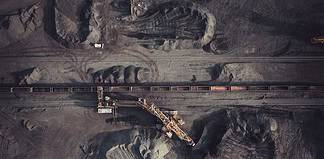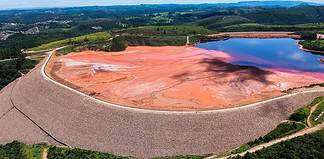Evolution Mining executive chairman Jake Klein speaking at IMARC. Image: IMARC.
BY ELIZABETH FABRI
EVOLUTION Mining executive chairman Jake Klein had a clear message for delegates at the recent International Mining and Resources Conference (IMARC) in Melbourne: the industry was experiencing a “cognitive bias” towards gold prices, with lack of sufficient returns rolling in for gold investors.
Evolution’s Mr Klein – who has steered the mid-tier miner’s growth since its inception seven years ago—questioned how many gold projects across the country delivered on what was promised in feasibility studies, shedding light on the industry-wide issue of narrow returns for investors.
“I started in the gold industry 25 years ago and gold prices were around $US250 an ounce and gold companies were able to make money. So, what has happened?” Mr Klein told delegates at IMARC.
“While we operate in a cyclical sector, I think we suffer from a cognitive bias in that we think the gold price is going to go up.
“In reality that is not a very good strategy, because the only thing we really know about the gold price in 12 months’ time is that it is going to be different.
“We hope it will go up but often it is lower.”
In early November the gold price was hovering around the $US1226 per ounce mark compared to $US1355/oz back in January.
Mr Klein said in light of the commodity’s uncertain trajectory, a good strategy for miners was to consider the challenges facing the industry, acknowledging that his company’s path to success hadn’t always been conventional.
Mr Klein said the Evolution board looked at portfolio opportunities through two lenses: will it improve the quality of its portfolio, and second will it be accretive to its shareholders.
“In the space of a mid-tier you really are able to generate enough money to fund yourself so you aren’t dependent on capital markets and you are able to generate growth, and that combination has delivered throughout the sector better than any other space,” he said.
“Fundamentally as a gold producer looking at creating a sustainable business, the only thing we can do is to produce gold at a low cost.”
And that Evolution had achieved; in the September quarter the miner produced 200,218 ounces of gold at an All-In Sustaining Cost (AISC) of $885 per ounce – making it one of the lowest cost producers globally.
Mr Klein said the next phase of its approach was understanding what to do with the dollars earnt.
“You can invest in an exploration find if there are more ounces. If there are not more ounces you can spend as much money as you like, you are not going to find them,” he said.
“We need to get more comfortable telling investors it is better not to spend money if that asset is going to run out [of ounces].”
Expansions
In Evolution’s case, the miner had a strong asset base with plenty of opportunities to expand within.
The company currently owned and operated five mines — Cowal in NSW; Mt Carlton, Mt Rawdon, and Cracow, in QLD; and Mungari in WA; as well as an economic interest in Glencore’s Ernest Henry mine in QLD.
After a solid start to the FY19 year, Evolution had its sights set on further growth, and was eyeing expansions at its Mt Carlton and Cowal mines on the east coast.
In early October its Cowal gold project obtained regulatory approval to increase the plant processing rate by 31 per cent from 7.5 million tonnes per annum (mtpa) to 9.8mtpa.
The $45 million expansion involved implementing a secondary crushing circuit at the processing plant, and the development of an Integrated Waste Landform (IWL) to facilitate storage of tailings over the life of mine.
Mr Klein said the approval to increase the processing plant was “a significant step” towards achieving its objective of increasing Cowal’s annual production rate to more than 300,000 ounces per annum.
Cowal currently had a mine life through to 2032 and several significant opportunities with drilling activities set to extend mine life at ore bodies outside of the main E42 pit, including E41, E46 and Galway/Regal.
A Float Tails Leach project, which was expected to increase recoveries by between 4 and 6 per cent, was also on schedule for commissioning in the December 2018 quarter.
Evolution had also subsequently green lit a $60 million underground development at the Mt Carlton mine, which included a Stage 4 pit cut-back and plant modifications.
Mt Carlton already had a mine life to at least 2025, and an expansion would allow production from a higher grade Link zone to be brought forward.
Mr Klein said he was “highly confident” that the initial underground reserve could be expanded, with additional drilling to be undertaken once the underground development was in place, to follow up on several promising drill intersections that were not currently included in the underground reserves or resources.
“Mt Carlton is a very high margin asset which has been a standout in Evolution’s portfolio,” he said.
“The mine has generated over $100 million in net mine cash flow in each of the last three years. The underground development of the Link zone ensures the continued production of high margin ounces.”
The company was currently awaiting regulatory approval for the project, with first ore scheduled from the underground in FY21.
Evolution was also undertaking an earn-in JV into Andromeda’s Drummond early stage gold project in northern QLD, 50km southwest of Mt Carlton.
Under the deal, Evolution could earn a 51 per cent interest in the project by making a cash payment of $300,000 and spending $2 million on exploration over two years.
At the completion of this first stage, Evolution could earn a further 29 per cent by making a cash payment of $200,000 and spending $4 million on exploration over two years.
Looking Ahead
With a busy year ahead, Mr Klein said the company’s focus remained on prioritising margins over production growth.
In FY18 the company produced 801,187 ounces of gold at an AISC of $797 per ounce and in FY19 was scheduled to produce between 720,000 and 770,000 ounces at an AISC in the range of between $850/oz and $900/oz.
“We are a relatively young company and we are building one that we believe is both unique and distinct,” Mr Klein said.
“In the seven years since our inception the company has grown a reputation as a transparent, consistent and reliable gold producer.
“Our balance sheet is strong, our assets are generating substantial cash flow and our business is now well positioned to prosper through the cycle.”








































